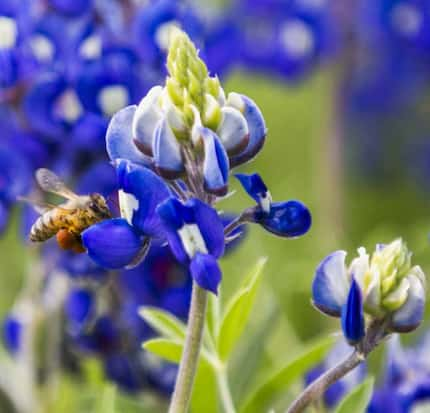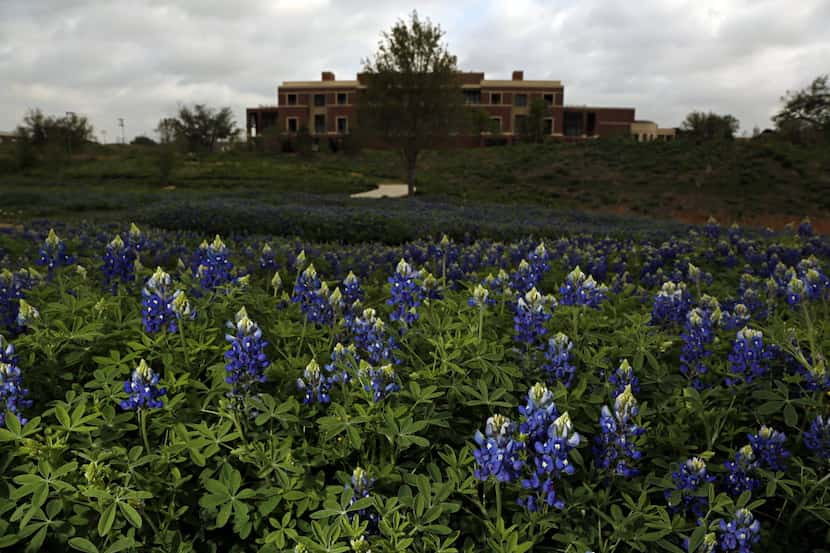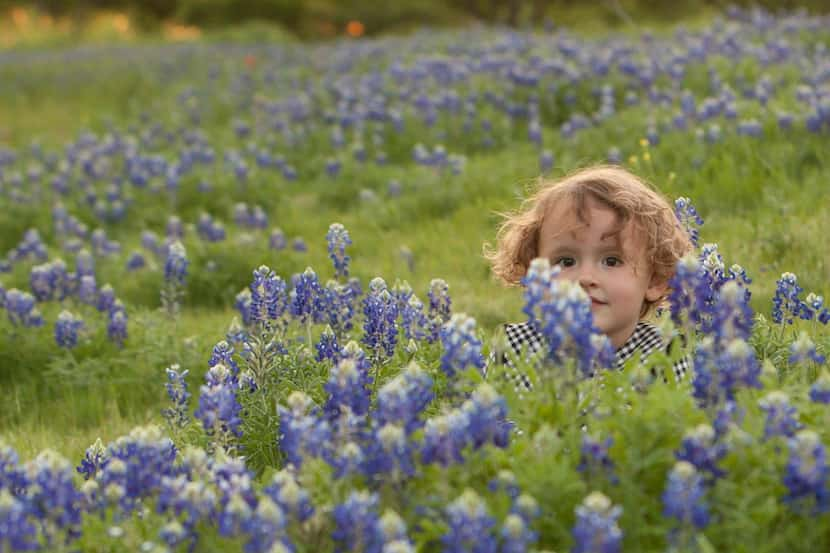It's a proud Texas tradition to set the little ones -- or yourself -- near some bluebonnets and snap away. So we've rounded up everything you need to know about Texas bluebonnets, including background info, a list of reliable places in D-FW for photos (note that weather can change a wildflower scene pretty quickly), photo tips and more.
What's a bluebonnet?
It's a flower, one of five or six species of Texas lupines. (Lupines have tapering spikes of flowers and are members of the legume family -- who knew?) Some say the bluebonnet got its name from the appearance of its flowers, which look kind of like little bonnets. We Texans love us some bluebonnets. In the words of historian Jack Maguire, "The bluebonnet is to Texas what the shamrock is to Ireland, the cherry blossom to Japan, the lily to France, the rose to England and the tulip to Holland."

The history
Did you know that Texas actually has multiple state flowers? Don't worry, your life is not a lie, they're all bluebonnets. In the spring of 1901, the Texas Legislature was picking a floral emblem (other candidates included the cotton boll and cactus, and if history had been different, perhaps you would have been carefully plunking down your toddler for the annual cactus photo). The will of the National Society of Colonial Dames of America in Texas prevailed with Lupinus subcarnosus, according to a 1989 Dallas Morning News story by Steven George.
And that's when what George calls "the polite bluebonnet war" started. "L. subcarnosus is a dainty little plant that paints the sandy, rolling hills of coastal and southern Texas with sheets of royal blue in the early spring. But some folks thought it was the least attractive of the Texas bluebonnets. They wanted L. texensis, the showier, bolder blue beauty."
The battle waged for 70 years, until the Legislature added the two species and "any other variety of bluebonnet not heretofore recorded" and lumped them all into one state flower.
The myths and the law
There are lots of bluebonnet myths. Since Spanish priests grew them around missions, a myth arose that the flowers were brought from Spain, but that's false. According to George, "the two predominant species of bluebonnets are found growing naturally only in Texas -- and noplace else."
But the most prevalent myth is probably that it's illegal to pick bluebonnets. That's also untrue, but as our Texana reporter, Charlie Scudder, wrote on the subject, "It may not be illegal to destroy the state flower, but it's almost certainly bad Texas karma." Nobody wants that.
Where to go in Dallas-Fort Worth
Things are looking good for this year's crop of bluebonnets, and experts say this year's wildflowers may arrive early and last several months.
George W. Bush Presidential Library and Museum: It's bluebonnet time, but you can also expect to see grasses and other seasonal wildflowers on 15 acres of grounds. And Laura Bush is a fan.

Ennis: The mapped Bluebonnet Trails cover about 40 miles in Ennis, about 40 minutes south of downtown Dallas. There's also a festival April 7-9. (For other Texas flower fests, try this.)
Cedar Hill State Park: Official Texan status can be achieved at this state park on the eastern shore of Joe Pool Lake at 1570 FM1382, Cedar Hill. Hey, it worked for her.
J.C. Penney headquarters: This is a favorite destination for Collin County bluebonnet seekers. Find it at 6501 Legacy Drive, Plano. And here's proof that a more candid photo can still be pretty darn sweet.
Photo tips
Here are five tips for getting the most out of your trip to see the state flower (oh, and we've got more here).
Keep an eye on things: Please don't have your subjects squat, lest they become the victim of the Pooping on Bluebonnets meme. Try to leave your background uncluttered. Nice backgrounds might be a field with more bluebonnets or the sky. Not-so-nice backgrounds might include cars or unattractive buildings. Don't hesitate to get close to your subject.
Pick your times (but not the bluebonnets): The warm, indirect light in the hour after sunrise and the hour before sunset tends to make for nice photos. If you've got to go at other times of day, you might want to look for a big block of shade or for cloud coverage for more even lighting.
Watch out for your shadow: Even during nice outdoor lighting times, photographers should keep an eye out for their own shadows showing up in the image.
Think off-center: The rule of thirds says that when you're composing visual images, you don't want your subject to be smack-dab in the middle. Experiment with having your subject off-center.
Follow the rules and have some fun: Be sure to follow any posted signs and use your common sense about road safety, insects and any other potential hazards. Leave the bluebonnets unscathed for everyone to enjoy (it's not illegal to pick them, but it's definitely not cool). Make sure little ones are well fed and rested when you head out. And don't be afraid to be silly.
About that meme
So, a bizarre social media trend based on the oft-awkward poses people get into to take bluebonnet photos became its own Tumblr called "Pooping on Bluebonnets." Here's what that's all about, if you want to learn more. And hey, odd bluebonnet photos don't always have to involve a poop emoji, we have plenty of proof of that from Reddit.
The song
The Texas state flower song, forthrightly titled "Bluebonnets," manages to get birds involved with poetry. Sample lyrics: "When the pastures are green in the springtime / And the birds are singing their sonnets / You may look to the hills and the valleys / And they're covered with lovely bluebonnets."


/cloudfront-us-east-1.images.arcpublishing.com/dmn/F5S2YSWWSFDL5ETVPWMAR4IIMM.jpg)
/cloudfront-us-east-1.images.arcpublishing.com/dmn/XVPEQJX4SRGT7OSHUVAKN5FFGQ.jpg)
:no_upscale()/cloudfront-us-east-1.images.arcpublishing.com/dmn/FVNFZF773ZGBBIMFHTQJFFNT2Y.jpg)
/cloudfront-us-east-1.images.arcpublishing.com/dmn/D4FJ726DTR6SREKVO4SCKYKNEE.jpg)
/cloudfront-us-east-1.images.arcpublishing.com/dmn/VVGIMAHWGFF2BPST7A36S4AYJY.jpg)